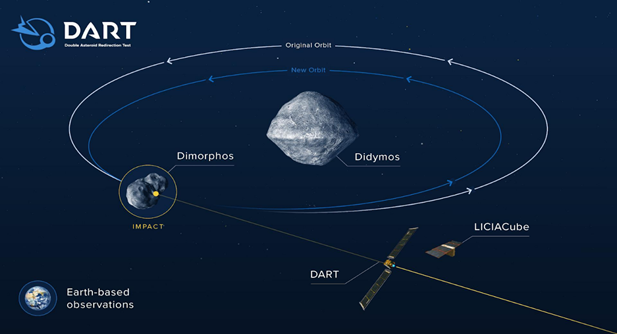Double Asteroid Redirection Test (DART) mission
- Posted By
10Pointer
- Categories
Science & Technology
- Published
27th Sep, 2022
-
Context
The National Aeronautics and Space Administration (NASA) is about to launch its Double Asteroid Redirection Test (DART) mission.

About the Launch
- It is the first Kinetic Impactor Method of planetary defence, where a DART spacecraft will be colliding with the asteroid Dimorphos.
- The Kinetic Impactor Method involves sending one or more large, high-speed spacecraft into the path of an approaching near-earth object.
- This could deflect the asteroid into a different trajectory, steering it away from the Earth's orbital path.
- Data obtained from DART’s crash will be compared to the data from various computer simulations run by scientists to ascertain whether this kinetic impactor method will remain a viable option in case of an actual threatening asteroid.
- Scientists don’t yet know the exact mass of Dimorphos but it is estimated to be around five billion kilograms.
- The DART spacecraft weighs around 600 kilograms.
About the DART Mission
- It is a planetary defence-driven test of technologies for preventing an impact on Earth by a hazardous asteroid.
- The spacecraft will be launched on a SpaceX Falcon 9 rocket from Vandenberg Space Force Base in California.
Objectives
- DART is the first technology demonstration of the kinetic impactor technique that could be used to mitigate the threat of an asteroid hitting Earth.
- The kinetic impactor mitigation technique is the impulsive deflection of the asteroid through the sudden addition of momentum.
- In simpler terms, DART is being sent to collide with an asteroid to change its orbital period.
Targeted asteroid by the DART mission
- It will target Dimorphos, the much smaller “moonlet” of a binary (two-body) asteroid system.
- Dimorphos orbits a larger asteroid named Didymos (Greek for “twin”) which has a diameter of 780 metres.
Why Dimorphos?
- Didymos is a perfect system for the test mission because it is an eclipsing binary which means it has a moonlet that regularly orbits the asteroid and it can be seen when it passes in front of the main asteroid.
- Earth-based telescopes can study this variation in brightness to understand how long it takes Dimorphos to orbit Didymos.
